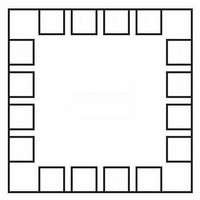LDS8620002-T2 Leadis Technology, LDS8620002-T2 Datasheet - Page 8

LDS8620002-T2
Manufacturer Part Number
LDS8620002-T2
Description
LED Drivers 200mA Dual Output w/ 1-wire intereface
Manufacturer
Leadis Technology
Datasheet
1.LDS8620002-T2.pdf
(12 pages)
Specifications of LDS8620002-T2
Number Of Segments
2
Low Level Output Current
0 mA
High Level Output Current
192 mA
Operating Supply Voltage
2.7 V to 5.5 V
Maximum Operating Temperature
+ 85 C
Mounting Style
SMD/SMT
Package / Case
TQFN EP
Minimum Operating Temperature
- 40 C
Lead Free Status / RoHS Status
Lead free / RoHS Compliant
LDS8620
programmed by first selecting the register address
and then programming data into that register.
An internal counter records the number of falling
edges to identify the address and data. The address
is serially programmed adhering to low and high
duration time delays. One down pulse corresponds to
register
correspond to register 2 being selected and so on up
to register 5. t
100μ s. Anything below 200ns may be ignored.
Once the final rising edge of the address pointer is
programmed, the user must wait longer than 500μ s
before programming the first data pulse. Any falling
edge after that will be recognised as a first data
pulse.
Data in a register is reset once it is selected by the
address pointer. If a register is selected but no data is
programmed, the next pulse sequence will be
recognized as data only. Do not select register
without data sending because it may disrupt normal
device operation.
Once the final rising edge of the data pulses is
programmed, the user must wait at least 2 ms before
programming another address. If programming fails
or is interrupted, the user must wait t
from the last rising edge before reprogramming can
commence.
Upon EN/SET
automatically seeks an address instruction. The
device requires a minimum 10μ s delay to ensure the
initialization of the internal logic at power-up. After
this time delay, EN/SET pin may be set high and the
device registers may be programmed adhering to the
timing constraints shown in Figure 1.
Register REG1 allows select the LEDs to be turned
on. Each of LEDs can be turned on independently by
setting the respective bit to 1.
Register REG2 allows to set the same current for all
channels. REG3 and REG4 allow to set the current
respectively in LED A and B. The LEDs can be
programmed with independent current values.
REG5 contains the return lockout (RTLKO) bit. This
stops the charge pump returning to 1x mode. One
pulse sets it to 1. Two pulses set RTLKO to 0. When
RTLKO is set to 1, the charge pump cannot
automatically return to 1x mode when in one of the
charge pump modes. The device can however move
from 1x to 1.33x, or to 1.5x and 2x if the input voltage
is not sufficient to drive the programmed LED
currents.
© 2008 Leadis Technology
Characteristics subject to change without notice
1 being selected. Two down pulses
LO
pin
and t
goes
HI
must be within 200ns to
high,
LEADIS TECHNOLOGY CONFIDENTIAL
RESETDELAY
the
PRELIMINARY
LDS8620
2 ms
8
REG5 also triggers the internal charge pump. This
forces the charge pump to start from 1x mode and
determine the correct mode it should operate to drive
the LEDs most efficiently. If V
device has been reprogrammed to other LED values,
it is recommended to trigger this reset allowing the
charge pump to run in the most efficient mode.
To power-down the device and turn-off all current
sources, the EN/SET input should be kept low for a
duration t
powers-down with a delay of about 1 ms. All register
data are cleared/reset.
Device allows multi flash mode operation using
1-wire interface. In this case, Registers 2, 3 or 4
should be programmed first to set output current.
Register Reg1 should be used to start flash event
with one or two channels depend on number of LED
turned on. Flash starts t
last data pulse. Use Reg1 address without data (one
pulse) to turn off flash. Next flash event may start any
time after t
Reg1 with data. (See Figure 3 for an example – multi
flash mode with maximum output current and all
LEDs turned on during the flash.)
Protection Modes
The LDS8620 has follow protection modes:
1. LED short to V
If LED pin is shorted to V
becomes as short circuit, or LED pin voltage is within
(V
condition as “LED Short” and disables this channel
with 750 µA control current. If LED pin voltage is less
than (Vout – 1.5V), LDS8620 restores LED current at
this particular channel to programmed value.
2. V
The charge pump’ output voltage V
limits at about 6.2 V maximum. This is to prevent the
output pin from exceeding its absolute maximum
rating.
3. V
If V
enabled, input current may increase up to 200 – 300
mA within 20 µs after enable and is limited to 35 – 40
mA after that.
4. Over-Temperature Protection
If the die temperature exceeds +150°C, the driver will
enter shutdown mode. The LDS8620 requires restart
after die temperature falls below 130°C.
OUT
OUT
OUT
OUT
- 1.5V) range, LDS8620 recognizes this
Over-Voltage Protection
Short Circuit Protection
is shorted to ground before LDS8620 is
OFF
RESETDELAY
of 1.5 ms or more. The driver typically
OUT
protection
(2 ms) by selecting register
DATADELAY
Doc. No. 8620DS, Rev. 0.4
OUT
IN
, LED burned out
(2 ms) later after
has risen or the
OUT
automatically













